Pterostylis falcata
R.S.RogersFlowering plant to 30 cm tall, stem smooth. Rosette leaves 3–5, ovate-lanceolate to elliptic, 3–8 cm long 1.5–2.5 cm wide, scattered on the basal part of the stem, sessile, margins entire. Flower 5–8 cm long, erect or semi-nodding, dark green and white; galea apex flat or a long, sweeping curve; dorsal sepal acuminate, much longer than petals; lateral sepals erect, loosely embracing the galea leaving a lateral gap, sinus deeply v-shaped when viewed from the front, protruding in a shallow curve when viewed from the side, free points linear-tapered, 3–4 cm long, erect or recurved, apex sometimes toothed; petals narrow, subacute. Labellum narrowly ovate-lanceolate, 25–34 mm long, 3–4 mm wide, brown, curved forwards in the distal half, subacute to obtuse, distal half protruding from the sinus in the set position. Flowers Oct.–Feb.
GleP, VVP, GipP, OtP, WaP, Gold, CVU, GGr, DunT, NIS, EGL, EGU, WPro, HSF, HNF, Strz, MonT, HFE, VAlp. Also SA, ACT, Tas. Widespread and often locally common, growing in wet situations such as seepage areas or near streams, on heavy clay or peaty soils.
Forms sporadic hybrids with Pterostylis nutans (see P. ×ingens) and with P. cucullata subsp. sylvicola (see P. ×aenigma).
Confused with Pterostylis lustra, but that species has smaller flowers usually with a more erect galea.
Jones, D.L. (1994). Pterostylis. In: Walsh, N.G.; Entwisle, T.J., Flora of Victoria Vol. 2, Ferns and Allied Plants, Conifers and Monocotyledons, pp. 798–830. Inkata Press, Melbourne.
 Spinning
Spinning


